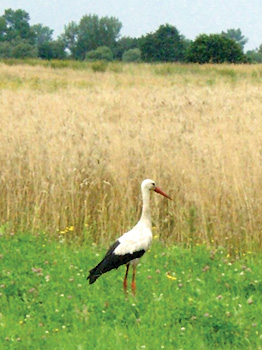|
1. Poland - a domain of white storks
Almost one-fourth of the world's population of white stork Ciconia ciconia nests are in Poland. Every 10 years, an International White Stork Census is carried out, covering the whole of Europe. In 2004, the sixth exercise of this kind was implemented. Many community organisations and scientific institutions participated in it. White stork is covered by species legal protection. It is also placed on the relevant list in the Birds Directive - a legal act of the European Union concerning the protection of rare bird species and their habitats. This act has been binding on the EU Member States since 1979.

|
|
White stork
phot. Kazimierz Walasz
|
2. Concerning the life of white storks
The first white storks usually arrive in Poland in mid-March. It is the males which occupy old nests first, with the females joining them later. In April, the females begin to lay eggs. A female lays 2 to 6, sometimes even 7 eggs. It is a rare occurrence, however, to find more than 4 chicks in one nest. In 2004 the average was about two chicks. They start to learn flying from early July to the beginning of August. Between the second part of August till the beginning of September, the storks start leaving their nesting sites in Poland and migrate to Africa for the winter. At that time, one can see large flocks of storks (of more then ten up to several dozen individuals) gathering in fields and meadows, which are either preparing for the journey or just resting en-route.
3. White storks in Kraków
At present, there are 18 nests of white storks in Krakow. This conspicuous nests mostly in the eastern and western parts of the city, where many wet meadows still exist, providing foraging grounds for the storks. In Krakow, storks nest chiefly on trees, and less often on power transmission poles or roofs of buildings. All these nests are either within built-up areas or in their immediate vicinity.
The locations of breeding sites (map) can be found here, together with photographs (as of 2004).
4. Threats and protection
The single most important threat to white storks is the changes in landscape features, caused by intensified cultivation, drainage, or expansion of land development. From the viewpoint of the urban landscape, the latter two causes are the most important. It happens quite often that the drying up of foraging sites prevents storks from getting enough food to feed the chicks in the breeding season. Increasing land development within the limits of the city brings about a major reduction in the area of habitats suitable for these large birds. Contacts with poorly insulation of high-voltage power lines is another factor that can result in bird fatalities.
In order to protect white storks in the landscape of Krakow, the priority measure would be to prevent any actions which could change the landscape. Also important are maintaining and fixing the existing nests, as well as moving those which are situated on old trees, on to special poles. While protecting the foraging sites of white storks, rich natural habitats of wet meadows and cultivated fields also benefit. These habitats are refuges to many valuable plant and animal species, most of which are small and inconspicuous.
Written by: Joanna Kudłek, Aleksandra Pępkowska, Kazimierz Walasz and January Weiner
|

